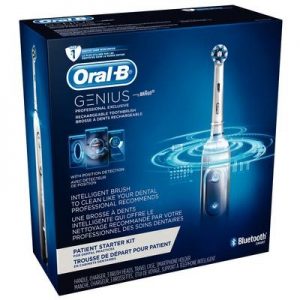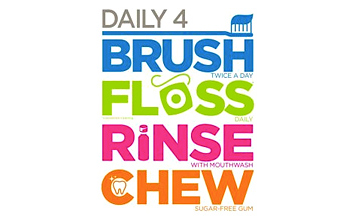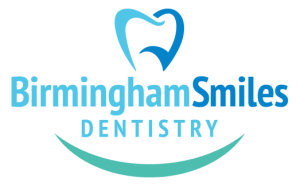The American Dental Association has designated October as National Dental Hygiene Month. So I thought this would be a great time to talk about the importance of good oral hygiene and the role it plays in your overall health. Here are some reminders and tips on ways you can make good habits at home in addition to having your regular cleaning and check up when you come see us!
4 daily routines that can help you maintain those healthy smiles:
- BRUSH
- FLOSS
- RINSE
- CHEW
BRUSH
The ADA recommends brushing your teeth twice a day, for two minutes, with a soft-bristled brush. Brushing twice a day not only removes food from in and around the teeth following meals, but also mechanically disrupts the plaque layer that forms on our teeth as bacteria break down the carbohydrates and sugar in our mouth over time. That is why it’s so important to spend a full two minutes ensuring that all tooth surfaces are given enough attention. Any spot that is routinely missed will be at an increased risk for developing a cavity!
But equally important to brushing consistently is to ensure that you are using the proper brushing technique:
- Place your toothbrush at a 45-degree angle to the gums.
- Gently move the brush back and forth in short (tooth-wide) strokes.
- Brush the outer surfaces, the inner surfaces and the chewing surfaces of the teeth.
- To clean the inside surfaces of the front teeth, tilt the brush vertically and make several up-and-down strokes.
- Brush your tongue to remove bacteria and keep your breath fresh.
We also get a lot of questions about which type of toothbrush patients should use.
The simple answer is that any toothbrush, if used properly and consistently, can be effective at keeping the teeth clean. However, there are many studies that show a powered brush is much more effective than a manual brush at reaching and cleaning a larger surface area of our teeth. The rotating, reciprocating brush head can move against the teeth hundreds of times faster than you can move a manual brush in two minutes. And these brushes are longer with a wider handle making it easier to hold and access those hard to reach places.

There are many good options for power brushes on the market but our favorite is the Oral-B Genius pictured below. It is state of the art technology for a power brush that includes 5 different cleaning modes, a pressure sensor that lets you know when you’re brushing too hard, a 2-minute timer, and even a Bluetooth connection to your smartphone. We keep these in stock at the office so let us know if you’re interested!
FLOSS
Although recent news reports may have questioned the benefits of cleaning between your teeth, it is still an essential part of taking care of your teeth and gums. We recommend flossing between your teeth at least once a day to remove plaque that cannot be removed effectively by brushing alone. Just like other surfaces of your teeth, if this plaque is not disrupted, it can eventually cause cavities or harden into calculus, which leads to inflammation, bleeding gums, and bone loss. One tip I like to give patients is to brush first with fluoride-containing toothpaste and then immediately floss between your teeth before you rinse your mouth out. This will force some of the remaining paste between the teeth for extra fluoride application in those areas!
RINSE
There are two aspects to consider for how rinsing can improve your oral hygiene. The first is using a mouthwash. Because teeth alone account for less than half of the mouth, rinsing can help eliminate extra biofilm and bacteria in the mouth that brushing and flossing may not focus on. Rinsing often, along with brushing and flossing, may help reduce the chance of dental decay and infection. However, mouthwash is intended to be an adjunct and not a replacement for brushing or flossing. Also, avoid alcohol-based rinses because they can dry out your mouth and irritate the soft tissues.
The second way to implement rinsing into your oral hygiene routine is to get in the habit of swishing water. Much the same way our saliva acts as a natural buffer to clean and protect the teeth, rinsing with water after eating or drinking will be a big help with removing leftover food after a meal or snack and washing away sugar and acid left behind by things like fruit, sodas, and energy drinks.
CHEW
Lastly, studies have shown that regularly chewing sugarless gum for about 20 minutes following meals can help prevent tooth decay. The chewing of sugarless gum helps by increasing saliva flow, which washes away food and other debris and neutralizes acids produced by bacteria in the mouth. Sugar-less gum can be even more beneficial when it contains a bacteria-fighting ingredient called xylitol.
Oral bacteria feed on glucose from our food, but they can not use xylitol. Replacing normal sugar with xylitol actually reduces the available fuel for the harmful bacteria. Additionally, even though these bacteria cannot use xylitol for fuel, they still ingest it. So when bacteria are full of xylitol, their metabolism becomes blocked and they literally starve to death. Studies show using xylitol-sweetened chewing gum can reduce levels of the bad bacteria up to 75%, while having no effect on the friendly bacteria.


